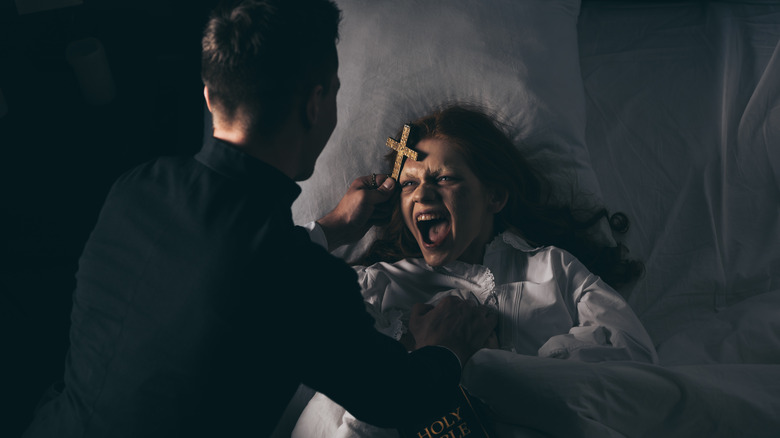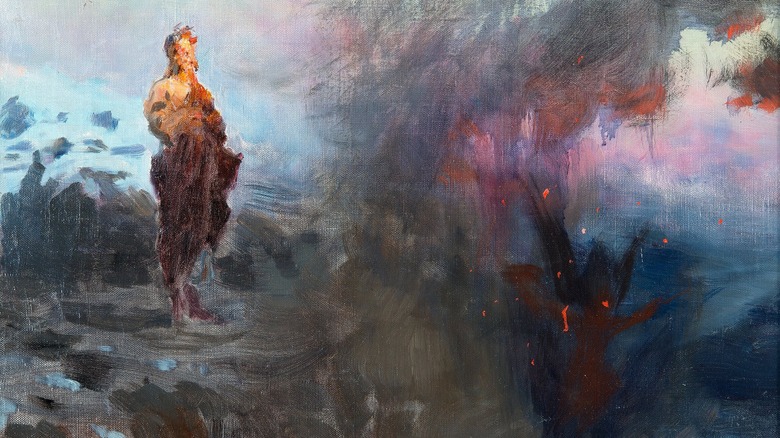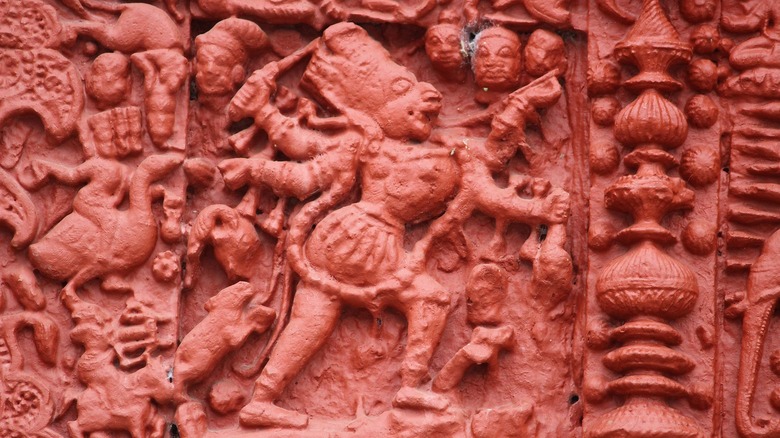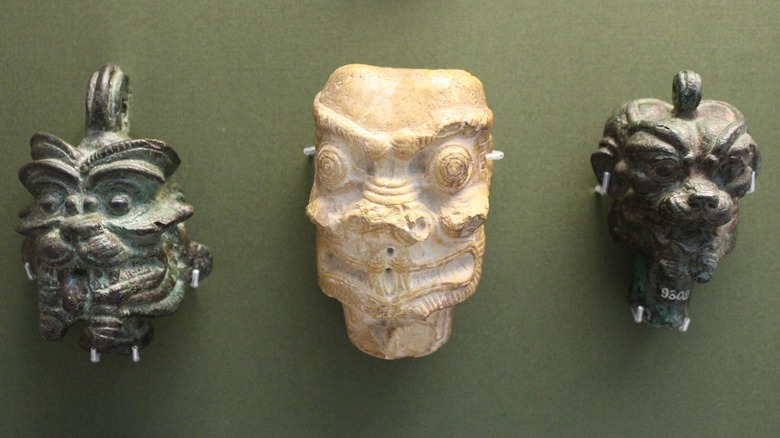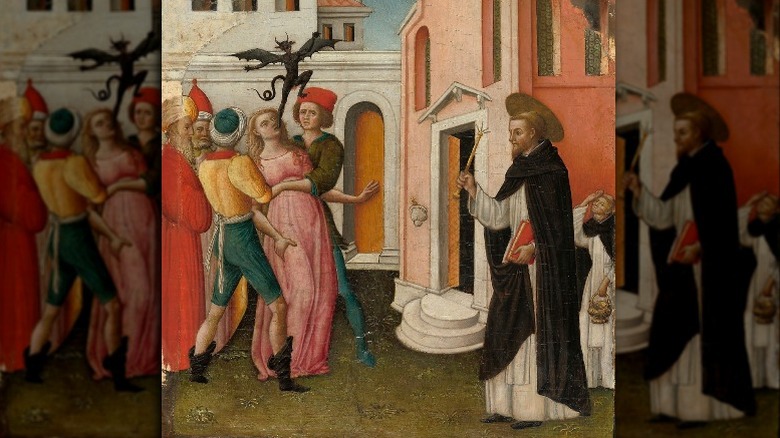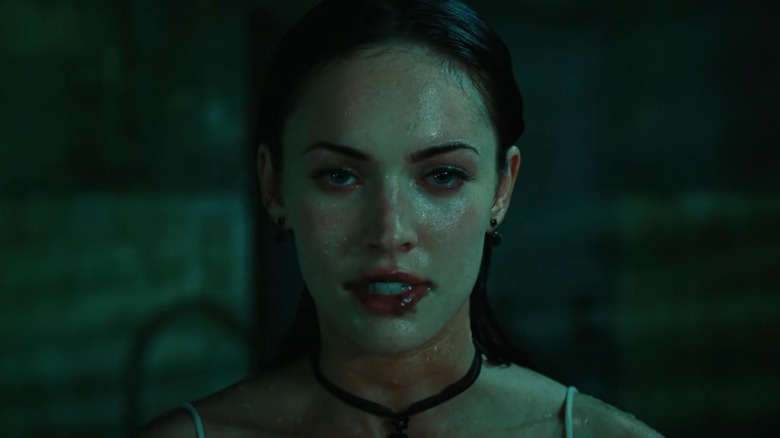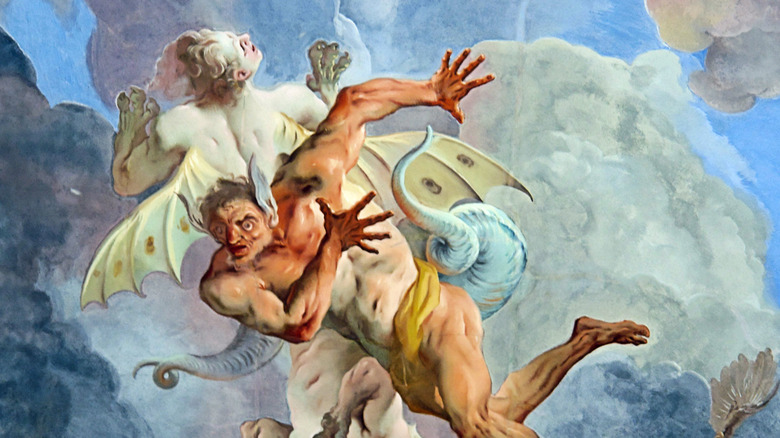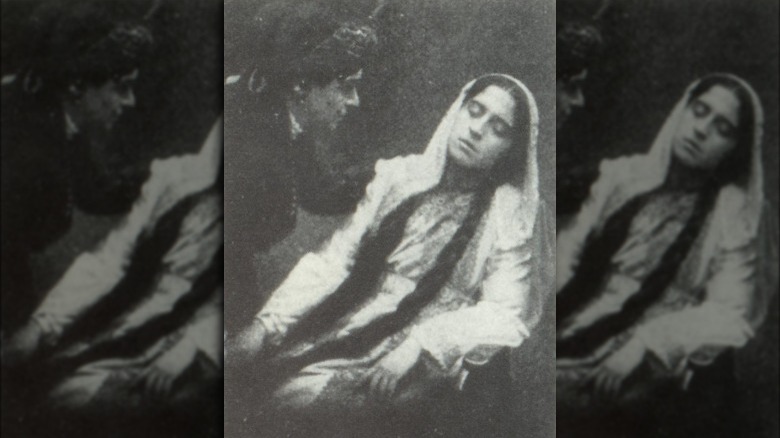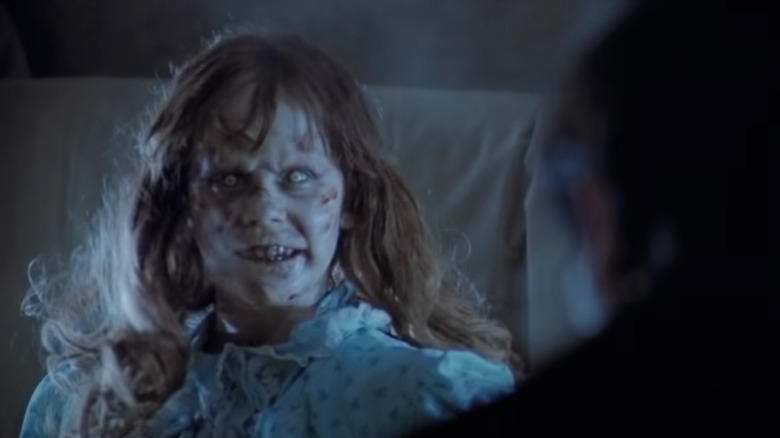What Hollywood Gets Wrong About Demons
If you're a horror movie fan, you may already be pretty familiar with demon lore — or, at least you might think you are. There's nothing wrong with enjoying a spooky, religious-themed horror movie, but in most cases, the difference between movies and reality is pretty wide. Perhaps you already know that Hollywood tends to stretch and sometimes even fully break the truth in an attempt to put out a gripping story.
Further, when it comes to spiritual or religious topics, there's a wide range of understanding and interpretation, meaning that the matter of finding the "truth" in the first place is pretty tricky. Trying to navigate the theological context of movies like "The Exorcist" or "Rosemary's Baby" doesn't exactly clear things up, and it can get very confusing and very tense for religious believers when religious beliefs and accepted theories are adapted and used as a basis for entertainment.
Considering that, it's no surprise that many say the movies often get things wrong about demons. Sometimes, like with the Babylonian demon Pazuzu in "The Exorcist," the films skirt the truth, but they almost never land squarely on it. Still, you may be surprised to learn that some of the most dramatic demonic scenes in cinema, from fallen angels to spinning heads spitting up seriously gross looking bile, don't have much basis in observed demonology or religious texts. Here's what Hollywood gets wrong about demons.
Jewish and Christian texts can be surprisingly vague about demons
A midnight viewing of a movie featuring possession might have you thinking that demons are not only everywhere, but that a properly dedicated researcher or exorcist can get some seriously detailed information about them. Yet, if you were to open up the Talmud or the Bible, you might find talk of demons seriously lacking. What gives?
First, as Jewish Virtual Library notes, there are issues that arise when translating ancient texts. Ancient Hebrew doesn't really have a word for what we consider a demon. In some texts, non-Jewish deities are called shedim, which some translate as "demons," but that could inspire some serious debate in the halls of a divinity school. And while there are certainly evil spirits, according to most interpretations of the Old Testament, information about them is vague. They live in ruins, some lines hint, and often cause sicknesses and misfortune. But, it's key to note that most translations acknowledge that these evil spirits are still fully under the dominion of God.
The New Testament suggests that people believed demons were linked to a cosmic adversary — the devil. Some demons, like Beelzebul or Beezebub (linked to the pagan god Baal-Zebub), are even named. But, beyond the mentions of "unclean spirits" and a few names here and there, there isn't much to base a movie on.
Demons aren't necessarily fallen angels
Some especially bombastic Hollywood films like to claim that demons are actually former angels who, having become rebellious and proud, turned against God and became evil demons. It's true that the Bible mentions fallen angels in a few short verses, (via King James Bible Online). But the link between these beings is pretty controversial.
The Journal of Biblical Literature points out that ancient Jewish believers didn't make that connection, nor did many early Christians. In fact, the belief that fallen angels and demons are one and the same didn't come until some time in the 2nd and 3rd centuries.
It gets more confusing when you try to define what a demon is in the first place. If they're generically an "unclean spirit," then you might be able to squeak those rebellious angels into the group on a technicality. But if you insist that demons are actively malevolent, repulsive spiritual beings who are in Satan's employ, you'd be standing on shaky textual ground. As "Angels and Demons" notes, some say that angels could never be demons, just by the fundamental nature of what it means to be an angel. An angel, they say, is purely good by definition. Something that can be corrupted and turned evil, then, could never have been an angel in the first place.
Demons aren't just a Christian thing
Hollywood has a pretty Western view, and Christianity often dominates any religious themes. You may get hints of other religions, sure, but many movies with a demonic plot are based in Christianity.
But even a quick glance reveals that demons feature in many other belief systems, not to mention foreign film industries. Per Britannica, there are plenty of religious texts and folklore stories that mention demons, including those from Judaism, Islam, and Zoroastrianism, which has its roots in ancient Iran. In fact, scholars believe that Zoroastrianism, which hinges on a cosmic battle between the forces of good and evil, may be the influence that pushed early Christians to demarcate their own battle lines between Heaven and Hell. Before that, the Christian idea of a cosmology of demons led by a ruler known as Satan wasn't nearly as set in stone as you may believe.
Of course, belief in demons extends far beyond those religions. Hindus attest that asuras are out there battling against good, while many varieties of Buddhism claim that demons are effectively tempters who try to knock you off the path to enlightenment. And, when it comes to movies, non-Christian demons pop up outside of Hollywood. Take the Indonesian horror industry, where Muslim and pagan demons wreak plenty of havoc for the unwary within the diverse cultural and religious beliefs of the region (via Paste).
The Exorcist was kind of right about Babylonian demons
William Friedkin's 1973 horror classic, "The Exorcist," which was based on a novel of the same name by William Peter Blatty, set the stage for many Hollywood demons. The film focuses on poor Regan MacNeil, a young girl who played with a Ouija board and then became the host to an ancient demon named Pazuzu (or, as the being claims later on, the Devil himself). Set in Washington, D.C., "The Exorcist" largely exists within a relatively modern Catholic cosmology that hinges on the existence of God and Satan and only vaguely touches on the real, complex world of Babylonian demons.
For one, as much as it seems like a Hollywood concoction, Pazuzu is a real member of the spiritual lineup, at least according to genuine Babylonian sources. According to the Metropolitan Museum of Art, Pazuzu was generally believed to be a humanoid monster with wings and a nasty snarl who was most popular around the 8th through 6th centuries BC. However, it appears that some people believed that his name and image acted as protection against demons.
It turns out that the world of Babylonian demonology was a pretty complicated one with true believers from numerous faiths. Aeon reports that Jewish residents of the region often used "incantation bowls" that, when deployed correctly, could counteract evil demons or even harness their power to help the user achieve their goals.
Few demonic possession cases rack up a body count
While movies might show demons killing hapless humans left and right, a look at most historical cases of reported possession may seem more like stage drama than bloodbath. According to LiveScience, Vatican guidelines list signs of demonic possession as including "superhuman strength, aversion to holy water, and the ability to speak in unknown languages," rather than extreme violence
That's not to say that some cases of demonic possession haven't been linked to lives lost or bodies that have been irrevocably injured. But, as LiveScience notes, many of those who have been seriously injured or killed during exorcisms seem to have met their fates not at the hands of the demon that was supposedly inhabiting them, but through the humans around them. People attempting to "cleanse" an affected person of their demon may become overly enthusiastic, allowing their fervor to go so far as to seriously harm the person they're trying to help. Others seem to have been dealing with significant mental illness that was misinterpreted as a religious battle between good and evil hosted within their own bodies.
Take the sad case of Anneliese Michel, a young German woman who believed that she was possessed. According to the Documentary Channel, Michel, who had already dealt with mental illness, eventually believed that she was host to multiple demons who needed to be starved out of her body. After Michel's death from starvation and dehydration, her parents and two priests were convicted of negligent homicide.
Exorcists often team up with mental health professionals instead of fighting them
Whether or not you genuinely believe that demons are out there wreaking havoc in our human world, mental illness is an indisputable fact. And, given that some mental illnesses can include hallucinations and delusions that can make it difficult for a person to distinguish reality from fiction, it's logical that some suspected demonic possession cases are really the product of psychosis. Films like "The Exorcism of Emily Rose" and "Requiem" suggest that the person suffering could be egged on by the faithful people around them, and end up displaying symptoms that appear to be possession.
In some demon movies, believers and scientists find themselves at odds, arguing over the reality of a seemingly haunted home or possessed person. But, lest you think this idea is the province only of nonbelievers, even the Vatican leans pretty hard on the mental health angle of things, to the point where Catholic priests frequently work with mental health professionals like psychiatrists (via the Washington Post). It's not always a perfect pairing. The Guardian notes that, even with a friendlier relationship with the sciences, exorcising priests may still end up abusing people who are in the throes of a delusional state or who they find odd or uncomfortable.
Jennifer's Body isn't quite right about succubi
The 2009 horror comedy "Jennifer's Body" received a lukewarm critical reception and less-than-stellar box office performance, per Box Office Mojo. But, in the years since, it's gained a cult following, with fans praising the film for its centering of female trauma and revenge. It follows the quasi-afterlife of Jennifer, a popular high school cheerleader who's sacrificed to the Devil by a struggling indie band desperate for success. The sacrifice goes awry, the human Jennifer departs, and a monstrous succubus inhabits her body.
While the succubus in "Jennifer's Body" is properly horrifying, often displaying a demonically unhinged jaw full of needle-like teeth and using it to literally eat her male victims, it's not quite accurate, at least according to historical accounts of succubi. And, if you think about it, voraciously consuming your victims all at once may be flashy, but is not a terribly sustainable practice.
Instead, as Encyclopedia.com reports, succubi were thought to be female demons who siphoned off the vitality of male victims by initiating amorous nighttime encounters with them. Some sources claim that the first man ever, Adam, had congress with these entities for over 130 years — hardly practical if they kept literally eating him. And, while the succubus of "Jennifer's Body" was sort of defeated by her host body being harmed, quite a few accounts state that the real solution is prayer-based or, as the Conversation reports, dependent on someone living a morally upright life.
Belief in demons may be more harmful than demons themselves
Most Hollywood films will have you believe that demons are the main cause of the trouble in cases of hauntings and possessions. But, while those films put the blame for all the trouble squarely on the demon's shoulders, the real issue may be with the believers themselves — even though they may not know it.
According to the Journal for the Scientific Study of Religion, the more someone is prone to believe in demonic activity, the more likely they are to suffer from negative mental health consequences. That same study found that some religious beliefs also offered a protective effect, like believing in divine justice or a rewarding afterlife. However, it's hard to ignore the stress and upset that can potentially be caused by someone's sincere and fervent belief that demons are out to get them.
Of course, things aren't quite as simple as saying that belief in demons and their effects may be more harmful than the actual thing. The Review of Religious Research found that people who were more likely to believe in "religious evil" were also more likely to come from disenfranchised groups with less power, such Black communities and members of "lower" social classes. Perhaps, some might say, the presence of unfairness or even evil in a person's life is more likely to push them towards belief in evil spirits.
Jewish demons don't work like they do in The Possession
While the vast majority of Hollywood films dealing with demons assume a Christian-centric worldview, there are a few exceptions. Take "The Possession," a 2012 horror film that claims to be all about the havoc that a Jewish demon wreaks on one family. The malevolent spirit comes from a "dybbuk box" and causes various sorts of trouble before being identified as a demon.
All spooky, sure, but it's not really in line with the traditional Jewish understanding of dibbukim or other evil spirits. First, as the Jewish Virtual Library explains, the initial interpretation of dibbukim was that they were evil spirits who entered the body of sick people. But then, another understanding arose. A dibbuk was a human who, having not received an appropriate burial and send-off, stuck around causing trouble for the people they possessed.
Per the American Library Association, a dibbuk (or dybbuk) is often understood as the soul of a sinner, stuck between here and the afterlife. It's connected to more mystical strains in Jewish theology, which sometimes posited that human souls could land in a new body (even if the body was sometimes already occupied). But the whole concept of a dybbuk is based on their takeover of someone's body, meaning that one taking up residence in an inanimate box is almost antithetical to the spirit's existence (via Skeptoid).
There isn't a whole lot of floating or head-spinning when a demon gets banished
Let's say that you accept there is a massive, cosmic war between the forces of good and evil, and that demons are effectively emissaries of the dark side that are sent forth to draw hapless humans away from the light. With that sort of belief, you might think that demonic possession is what it's like in the movies. It's got to be dramatic, right? Shouldn't an evil spirit taking up residence in someone's body produce eye-catching results, from rotating heads to a disgusting fountain of — well, let's just say it looks like split pea soup and leave it at that. And surely someone involved starts levitating, if nothing else.
But, yet again, the movies got it wrong. According to multiple exorcists, demons are cast out with a bunch of prayer and little else. Father Gary Thomas, a rather well known modern Catholic exorcist interviewed by Cosmopolitan, says that an exoricism starts with "setting-the-table prayers." He also anoints doorways with holy oil to entrap the demon, and then starts in on sacrament and scripture readings, interspersed with yet more prayers. "Manifestations" like the possessed person speaking in a language they don't usually know or unusual strength may occur. However, neither Thomas nor Father Budi, a priest interviewed by Vice, say that the more dramatic, cinematic things seen in films like "The Exorcist” have ever occurred in their experiences of real exorcisms.
